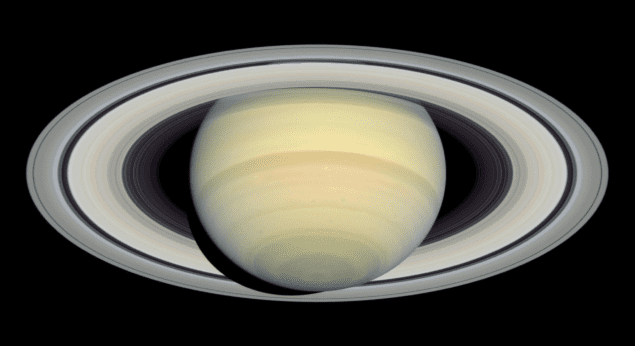
Saturn’s rings are just 100 million years old and formed when dinosaurs roamed Earth. This is much younger than Saturn, which formed about 4.5 billion years ago. Their age was determined by studying doppler-shifted radio signals from the doomed Cassini spacecraft. The signals were transmitted during the mission’s final orbits around Saturn and have also revealed startling details about the unseen interior of the planet.
Cassini used its Radio Science Subsystem to measure Saturn’s gravitational field. Saturn’s gravity tugged on the spacecraft, so any radio signals it beamed back to Earth exhibit a tiny Doppler shift, just 10 cm/s, as a consequence.
Radio transmissions made earlier in the mission, from outside of Saturn’s rings, gave a measurement of the gravitational field of both the planet and its rings. Cassini’s “grand finale” in 2017, however, saw the spacecraft’s orbit move inwards, between the planet and the rings, before the spacecraft entered Saturn’s atmosphere and was destroyed on 15 September 2017. By travelling between the planet and the rings, the radio signals were Doppler-shifted by gravity acting in different directions – the planet alone on one side, and the rings on the other. By disentangling these signals, it was possible to obtain a more accurate measurement of the gravity of the planet alone.
The gravitational field measurements were different to what scientists expected. To explain them, scientists led by Luciano Iess of Sapienza University of Rome have shown that the outer 15% of the planet – down to a depth of 9000 km below the cloud-tops – is rotating faster than the interior of the planet.
Massive jet
“We predict that there is a massive jet near the equator that rotates 4% faster than the rest of the planet,” says team member Burkhard Militzer, of the University of California, Berkeley.
The consequence of this jet, the origin of which is currently uncertain, is that by speeding up the rotation of the outer 15% of the planet, it increases the centrifugal force, resulting in part of the outer atmosphere uplifting slightly, affecting the planet’s gravitational pull. In comparison, Jupiter only experiences differential rotation in its outer 3%, to a depth of 3000 km, according to measurements by NASA’s Juno spacecraft.
The results are consistent with models of Saturn’s core being made of elements heavier than hydrogen and helium. These elements are believed to total 15–18 times the mass of Earth, which is about 15% of the mass of Saturn.
Bottom-up formation
The knowledge that Saturn contains a large core of heavy elements provides crucial insight into how Saturn, and possibly the other gas giant planets, formed. It bolsters models that depict these planets forming from the bottom-up, first assembling as a large rocky core and then accreting huge swathes of gas from the planet-forming disc that gave birth to the Solar System.
The findings from Cassini’s Radio Science Subsystem have also answered one other long-standing question about Saturn: the age of its rings. By disentangling the Doppler-shifted signals, the gravitational field from just the rings was also isolated. This allowed Iess’ team to measure the mass of just the rings, which they found to be 1.5 x 1019 kg. This is equal to about two-fifths of the mass of Saturn’s icy 198 km-wide moon, Mimas.
When the rings formed they were likely made from pure ice, but over the years meteoritic dust has polluted them. By knowing the mass of the rings, and how much of that mass is composed of dust (about 1%), the researchers were able to calculate how long it would have taken for the rings to accumulate that much dust. Their answer is about 100 million years. In other words, the rings probably formed during the time that dinosaurs roamed the Earth.
Raining ring particles
The results tally with other research described in the journal Icarus that reveals that Saturn’s rings will be short-lived, and that all the ring particles will have rained into Saturn’s atmosphere within 100-300 million years.

Cassini’s grand finale
“I think it is incredibly telling that we have now seen several separate results, using very different techniques, that have all independently suggested a surprisingly short age for Saturn’s rings,” says Tom Stallard of the University of Leicester and a co-author of the Icarus paper.
However, Stallard points out that knowing the age of Saturn’s rings does not tell us how they formed. The leading theory is that an icy moon or a large comet crossed the Roche limit, which is the minimum distance and object can get to Saturn before the planet’s gravity tears them apart.
In cosmic terms, Saturn’s rings won’t last very long, and we may be very lucky to be around at the same time they are. “This result does suggest that the chances of detecting Saturn-like rings [around exoplanets] might be less likely than we might hope,” says Stallard.
Iess and colleagues describe their observations in Science.



